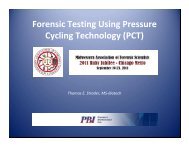Isolation of Mitochondria from Rat Lung Using The PCT Shredder and
Isolation of Mitochondria from Rat Lung Using The PCT Shredder and
Isolation of Mitochondria from Rat Lung Using The PCT Shredder and
You also want an ePaper? Increase the reach of your titles
YUMPU automatically turns print PDFs into web optimized ePapers that Google loves.
mg yield per gram tissue<br />
Application Note: <strong>Rat</strong> <strong>Lung</strong> <strong>Mitochondria</strong>l Preparation<br />
After <strong>PCT</strong> or control treatment, the contents <strong>of</strong> the<br />
3 PULSE Tubes were pooled back together, <strong>and</strong><br />
the samples were centrifuged for 8 minutes at<br />
1000 x g. Any remaining lung tissue debris was<br />
carefully removed (in some cases a sample was<br />
spun a second time to remove remaining tissue)<br />
<strong>and</strong> the supernatant was transferred to a clean<br />
centrifuge tube. Removal <strong>of</strong> tissue debris was<br />
found to be easier <strong>from</strong> samples that had been<br />
pressurized at 20,000 psi; this may have occurred<br />
if the tissue was less buoyant due to the air sacs<br />
collapsing during pressure cycling. Samples that<br />
were pressurized to only 10,000 psi, or control<br />
tissue that was not pressurized, did not pellet<br />
easily.<br />
<strong>The</strong> mitochondria-enriched fraction was pelleted<br />
<strong>from</strong> the supernatant by centrifugation for 8<br />
minutes at 14,000 x g. <strong>The</strong> resulting pellet was<br />
gently suspended in 1.5 mL <strong>of</strong> fresh isolation<br />
buffer (MMIB or N2). <strong>The</strong> suspension was<br />
transferred to a 1.5 mL micr<strong>of</strong>uge tube <strong>and</strong> was<br />
centrifuged a second time at 14,000 x g. <strong>The</strong> final<br />
pellet was suspended in 50 μL <strong>of</strong> isolation buffer<br />
by gentle homogenization with a small plastic<br />
pestle.<br />
Results <strong>and</strong> Discussion<br />
Here we describe a novel method for preparation<br />
<strong>of</strong> mitochondria-enriched fractions <strong>from</strong> frozen rat<br />
lung tissue suitable for proteomic applications.<br />
We demonstrate that mitochondria, extracted<br />
using <strong>The</strong> <strong>PCT</strong> <strong>Shredder</strong> with or without<br />
subsequent <strong>PCT</strong> treatment, are intact <strong>and</strong> can be<br />
used for proteomic studies <strong>and</strong> other applications<br />
equally as well as conventional methods.<br />
<strong>Mitochondria</strong> were efficiently extracted when<br />
tissue was homogenized by a ten second<br />
disruption in <strong>The</strong> <strong>PCT</strong> <strong>Shredder</strong>. Yield was<br />
significantly increased when shredding was<br />
followed by <strong>PCT</strong> treatment for 5 cycles at 20,000<br />
psi (Figure 2). <strong>The</strong> yield <strong>of</strong> mitochondria was<br />
consistent whether the isolation was performed in<br />
salt-based buffer (MMIB) or in sucrose-based<br />
buffer (N2). Additional cycles <strong>of</strong> pressure (20,000<br />
psi for 15 cycles) did not improve yield.<br />
In Figure 3, 2D PAGE results indicate that the<br />
protein pr<strong>of</strong>iles <strong>of</strong> control mitochondria samples,<br />
isolated solely by a homogenizer, are essentially<br />
the same as the test samples prepared using <strong>The</strong><br />
<strong>PCT</strong> <strong>Shredder</strong> with or without subsequent <strong>PCT</strong><br />
treatment.<br />
Coomassie blue-stained SDS-PAGE gels <strong>and</strong><br />
Western blots (Figure 4) confirm that mitochondrial<br />
samples isolated by a homogenizer are essentially<br />
the same as samples prepared using <strong>The</strong> <strong>PCT</strong><br />
<strong>Shredder</strong> with or without pressure cycling,<br />
indicating that this combination <strong>of</strong> methods can be<br />
used to safely, easily <strong>and</strong> reproducibly generate<br />
high quality mitochondrial preparations.<br />
1.2<br />
0.9<br />
0.6<br />
0.3<br />
0<br />
<strong>Mitochondria</strong> Yield <strong>from</strong> Frozen <strong>Rat</strong> <strong>Lung</strong> Tissue<br />
MMIB<br />
Homog<br />
MMIB<br />
Shred<br />
alone<br />
MMIB<br />
Shred<br />
<strong>PCT</strong><br />
10,000<br />
psi<br />
MMIB<br />
Shred<br />
<strong>PCT</strong><br />
20,000<br />
psi<br />
N2<br />
Homog<br />
N2<br />
Shred<br />
alone<br />
N2<br />
Shred<br />
<strong>PCT</strong><br />
10,000<br />
psi<br />
N2<br />
Shred<br />
<strong>PCT</strong><br />
20,000<br />
psi<br />
Figure 2. Yield <strong>of</strong> <strong>Mitochondria</strong><br />
<strong>Mitochondria</strong> were prepared in either MMIB or N2 buffer.<br />
Tissue was homogenized using a homogenizer, <strong>The</strong> <strong>PCT</strong><br />
<strong>Shredder</strong>, or <strong>The</strong> <strong>PCT</strong> <strong>Shredder</strong> followed by <strong>PCT</strong> at 10,000 or<br />
20,000 psi for 5 cycles.<br />
In addition, Western blots confirm that the<br />
mitochondria preparations are enriched for protein<br />
markers for all three mitochondrial compartments,<br />
providing further evidence that the mitochondria<br />
are intact (Figure 4). <strong>The</strong> presence <strong>of</strong> GAPDH in<br />
all the preparations is likely due to carryover <strong>of</strong><br />
cellular cytosolic material, which could be further<br />
reduced by additional washing <strong>of</strong> the mitochondrial<br />
pellet. <strong>The</strong> presence <strong>of</strong> actin in the mitochondrial<br />
pellet is expected, as it has been reported to be<br />
associated with mitochondria [6].<br />
Two different buffers (N2 <strong>and</strong> MMIB) were used in<br />
this application to demonstrate that <strong>The</strong> <strong>PCT</strong><br />
<strong>Shredder</strong> <strong>and</strong> <strong>PCT</strong> treatment can be used with<br />
different types <strong>of</strong> mitochondria isolation reagents<br />
for compatibility with various downstream methods.<br />
Conclusion<br />
We have demonstrated a convenient isolation<br />
method for intact mitochondria <strong>from</strong> frozen rat lung<br />
tissue using <strong>The</strong> <strong>PCT</strong> <strong>Shredder</strong> for initial tissue<br />
disruption, with or without subsequent <strong>PCT</strong><br />
treatment. <strong>The</strong> mitochondria, isolated using this<br />
novel method, are comparable to controls <strong>and</strong> can<br />
be used for proteomic <strong>and</strong> other studies.<br />
Similar methods have been used with fresh rat<br />
kidney <strong>and</strong> muscle tissue to extract functional<br />
Pressure BioSciences, Inc.<br />
14 Norfolk Avenue, South Easton, MA 02375<br />
TEL 508-230-1828 FAX 508-230-1829<br />
www.pressurebiosciences.com












